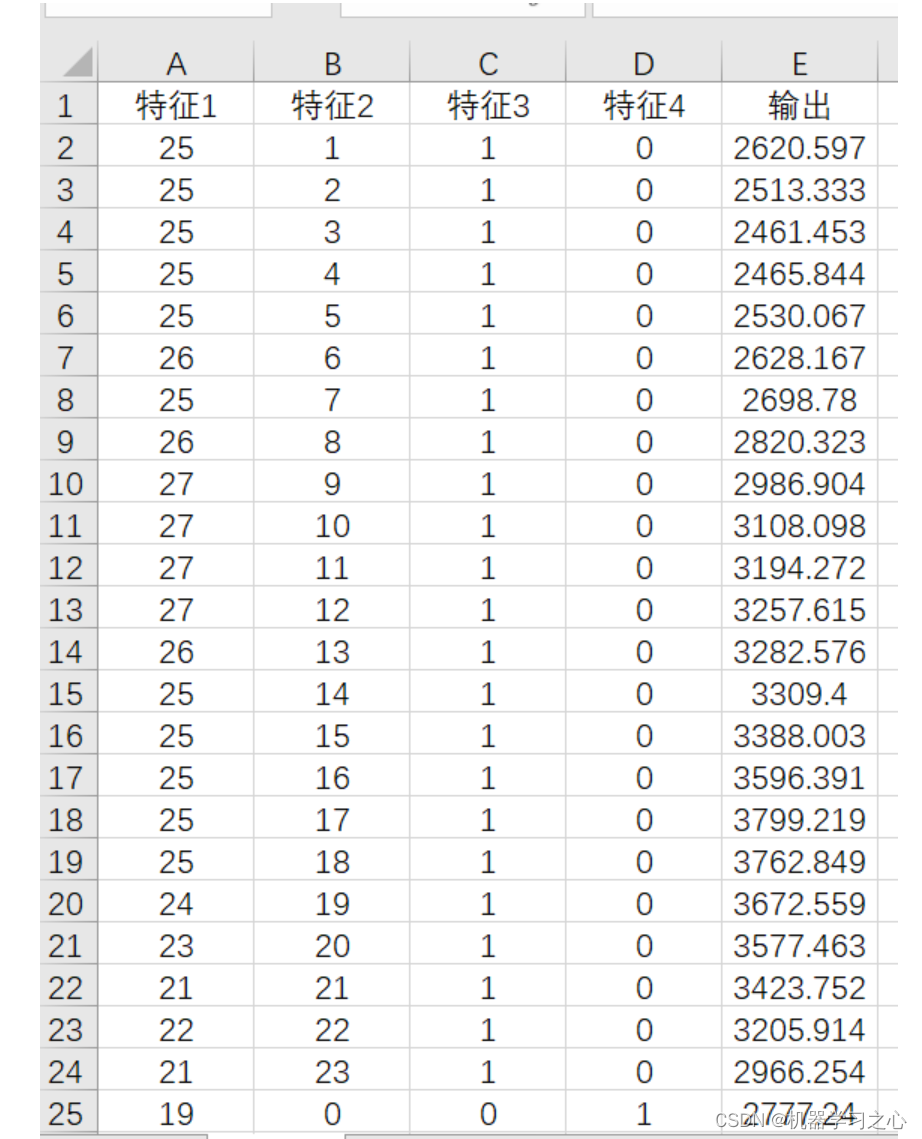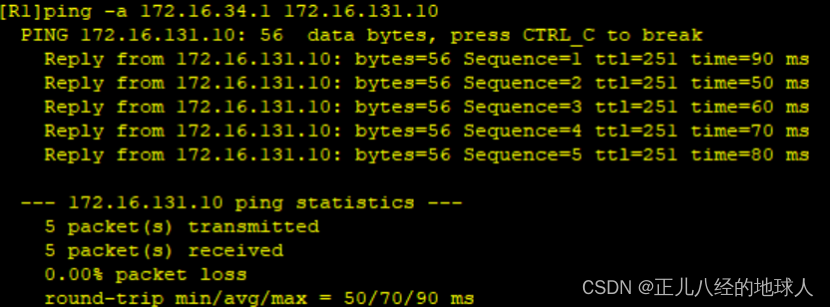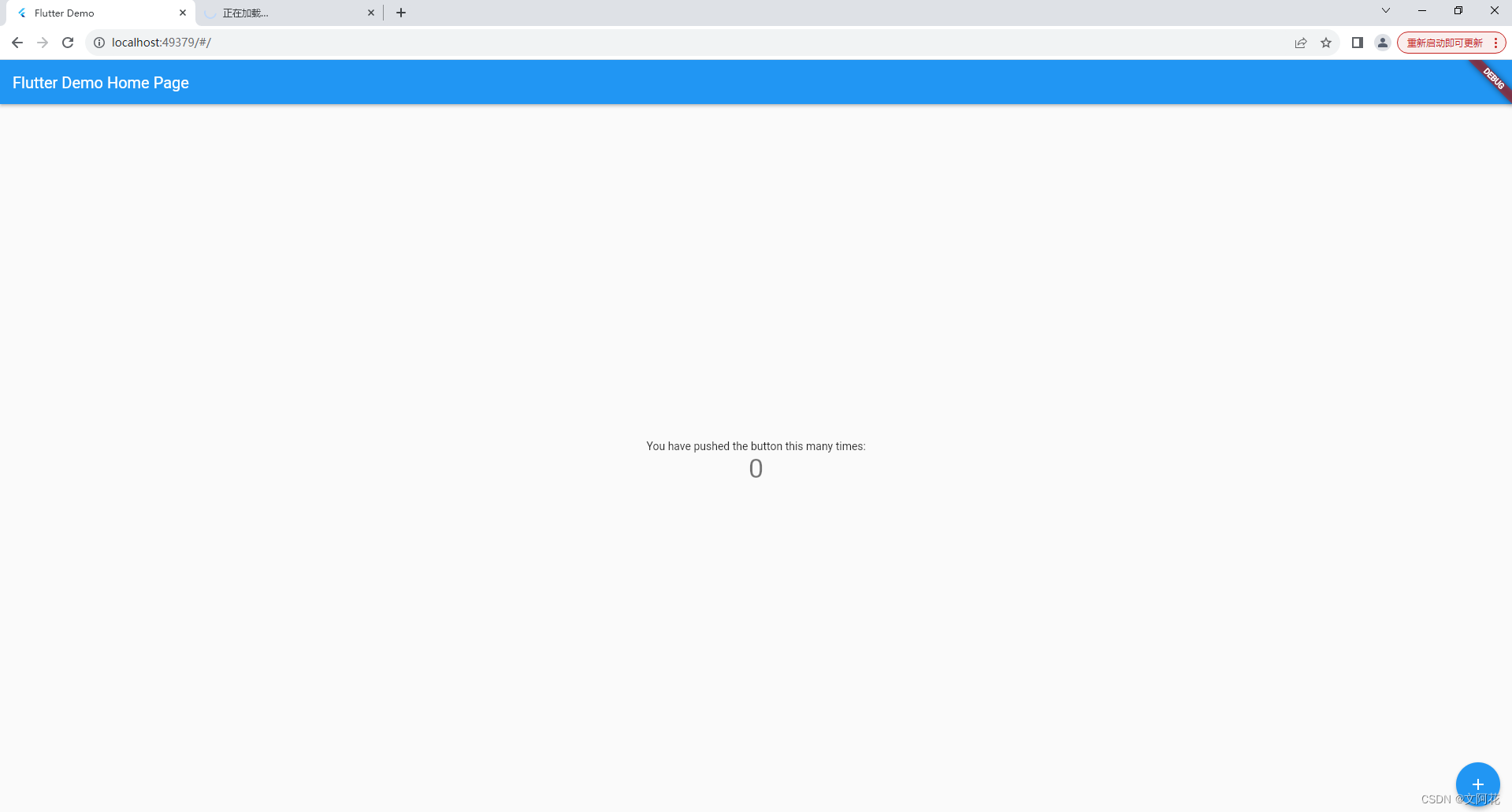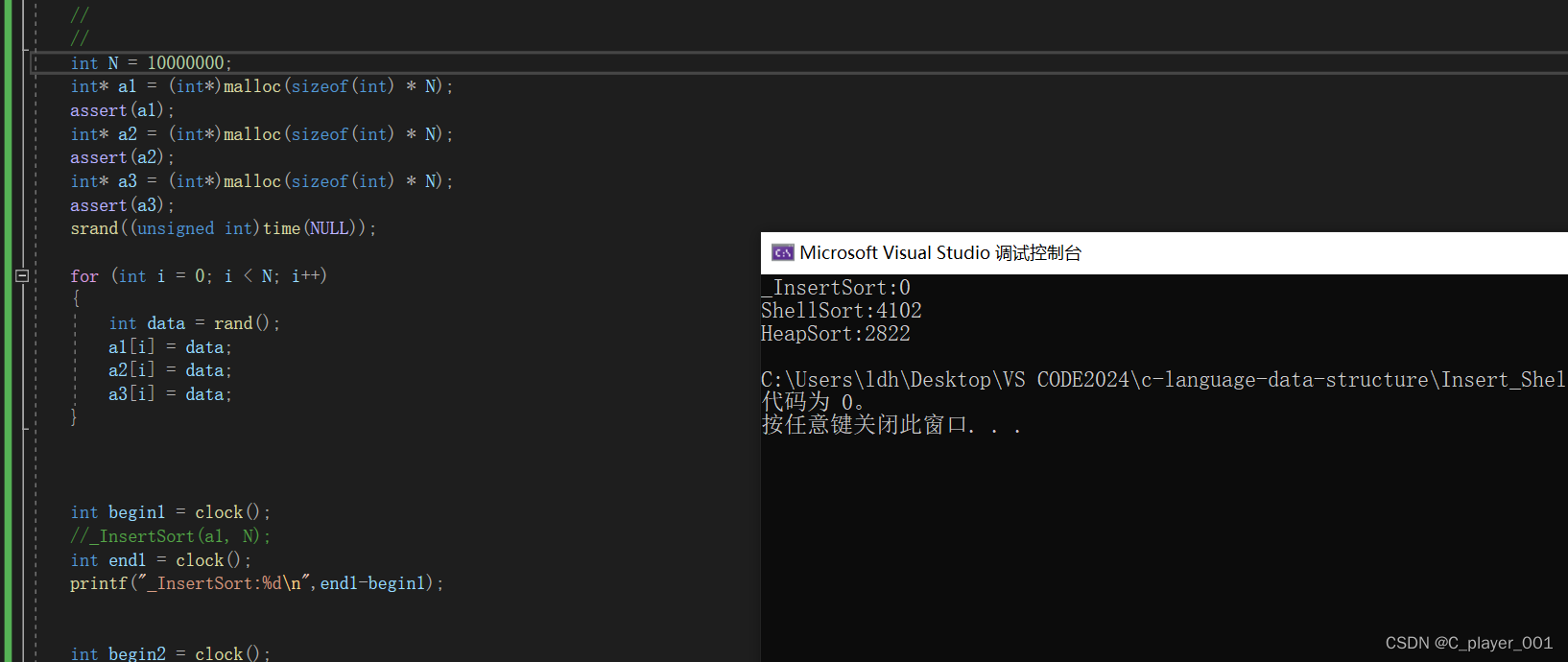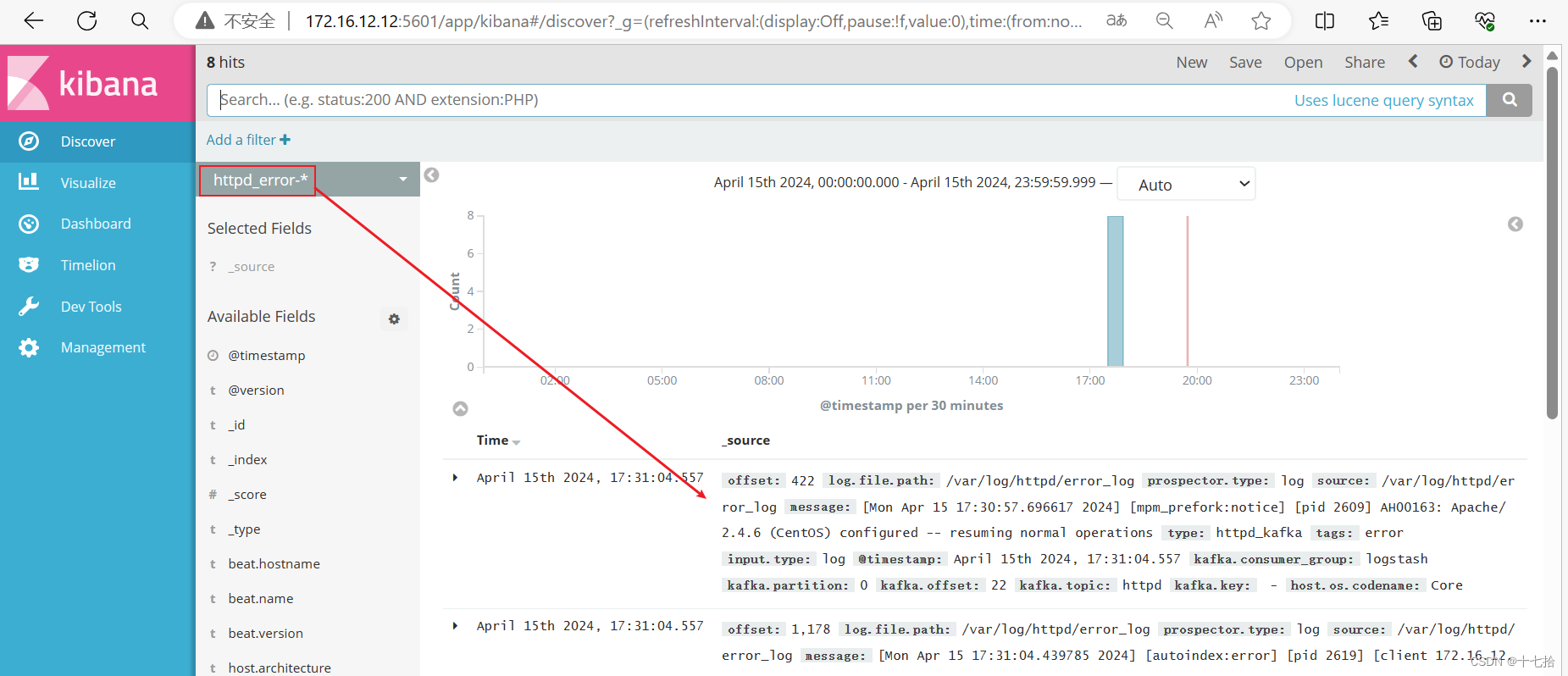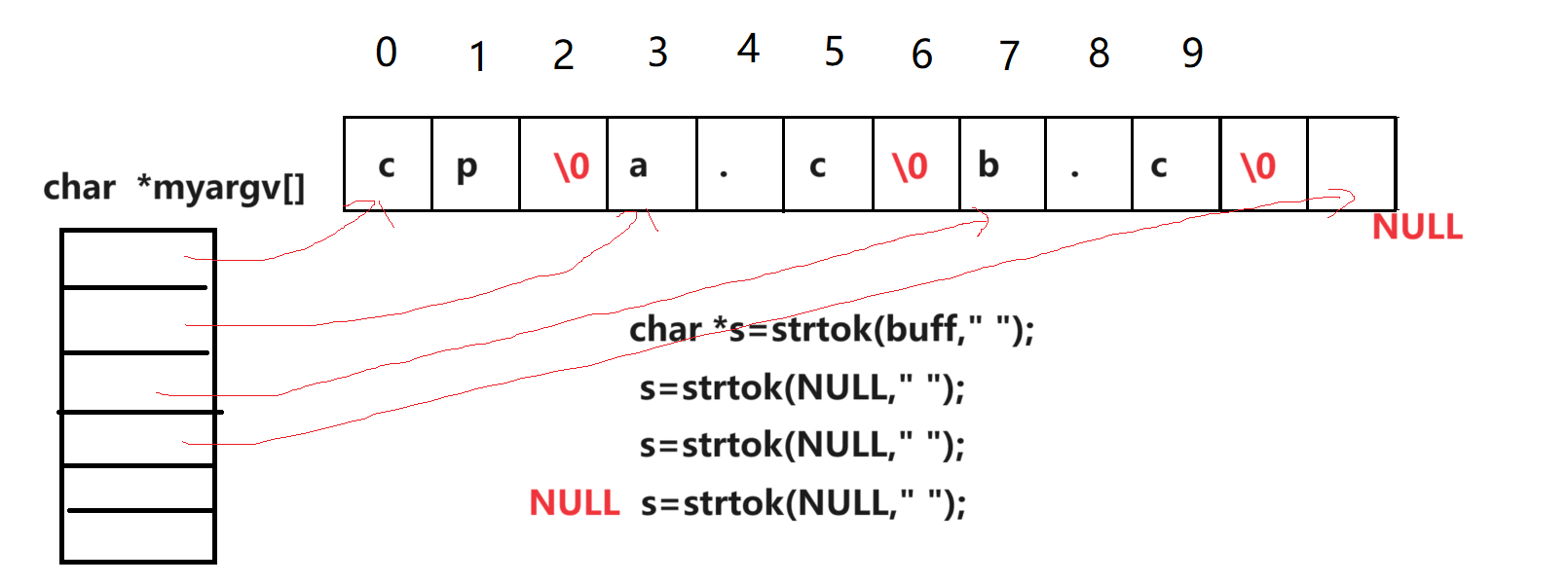- 前言
- 1. 初步认识数据结构
- 2. 线性表
- 3. 顺序表
- 3.1 顺序表的概念
- 3.1 顺序表的分类
- 3.2 动态顺序表的实现
- 结语

前言
各位小伙伴大家好!小编来给大家讲解一下数据结构中顺序表的相关知识。

1. 初步认识数据结构
【概念】数据结构是计算机存储、组织数据的⽅式。
- 数据结构是指相互之间存在⼀种或多种特定关系的数据元素的集合
- 数据结构反映数据的内部构成,即数据由那部分构成,以什么⽅式构成,以及数据元素之间呈现的结构
- 数据结构能够存储数据(如顺序表、链表等结构)
- 数据结构存储的数据能够方便查找
- 数组是最基础的数据结构
2. 线性表
【概念】零个或多个数据元素的有限序列。
【分类】
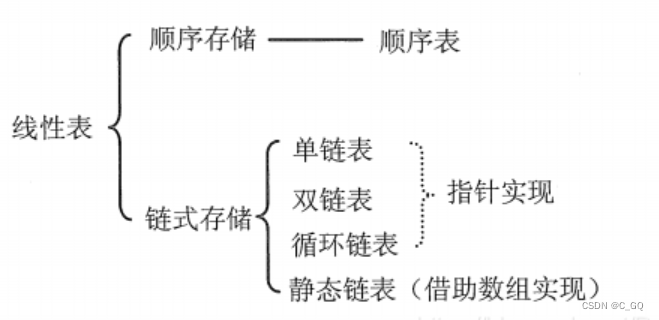
【补充】

3. 顺序表
3.1 顺序表的概念
【概念】用一组地址连续的存储单元依次存储线性表的数据元素,这种存储结构的线性表称为顺序表。
【特点】逻辑上相邻的数据元素,物理次序也是相邻的。
3.1 顺序表的分类
【分类】
-
静态顺序表:使用定长数组存储元素。
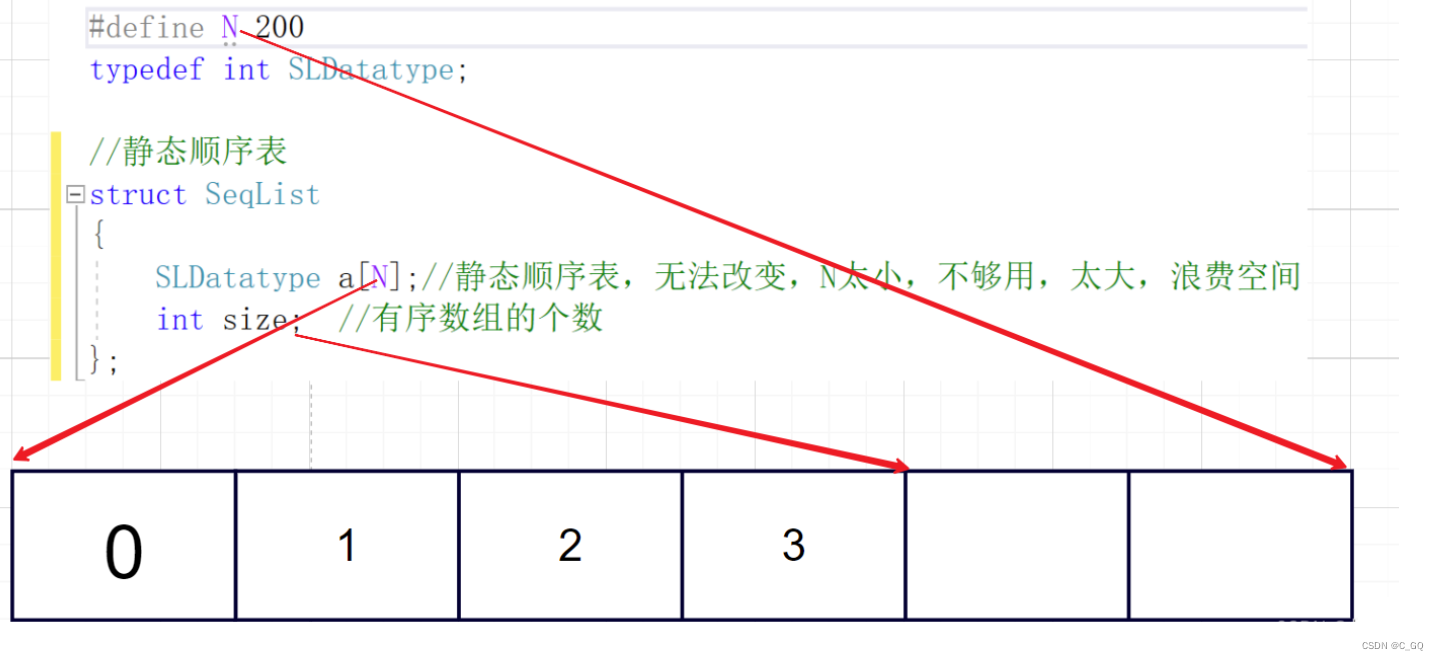
-
动态顺序表:使用动态开辟的数组存储。
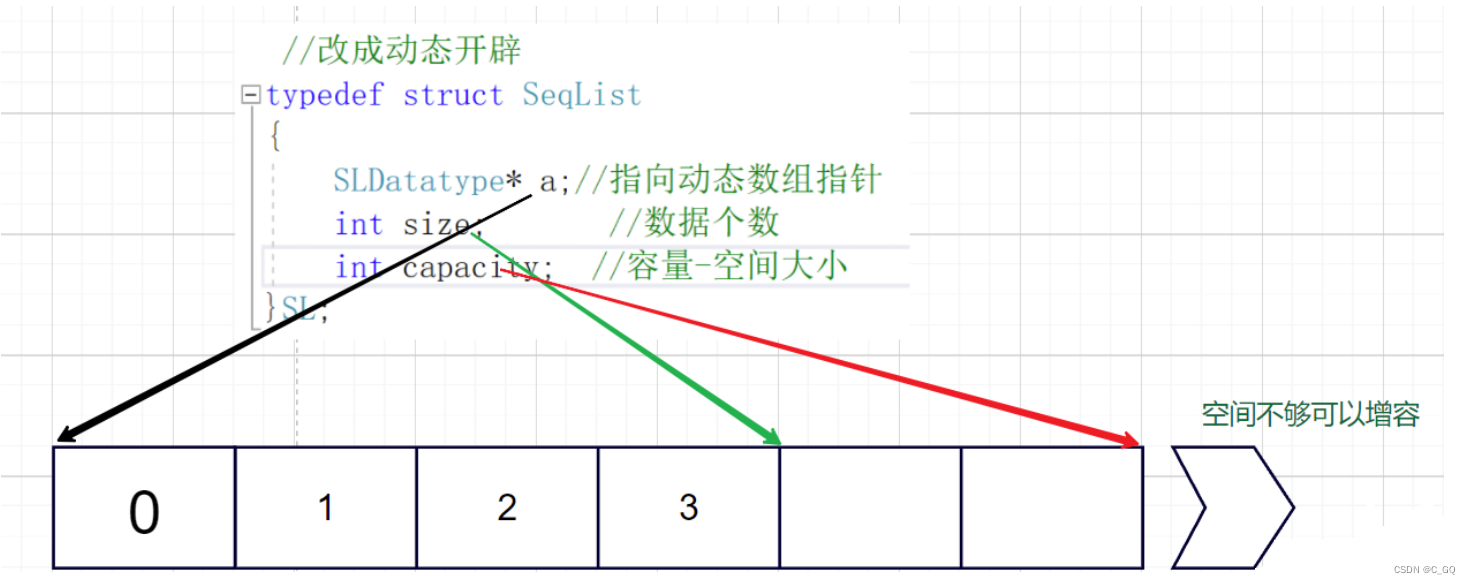
3.2 动态顺序表的实现
#define INIT_CAPACITY 4
typedef int SLDataType;
// 动态顺序表 -- 按需申请
typedef struct SeqList
{
SLDataType* a;
int size; // 有效数据个数
int capacity; // 空间容量
}SL;
//初始化和销毁
void SLInit(SL* ps);
void SLDestroy(SL* ps); 、
void SLPrint(SL* ps);
//扩容
void SLCheckCapacity(SL* ps);
//头部插⼊删除 / 尾部插⼊删除
void SLPushBack(SL* ps, SLDataType x);
void SLPopBack(SL* ps);
void SLPushFront(SL* ps, SLDataType x);
void SLPopFront(SL* ps);
//指定位置之前插⼊/删除数据
void SLInsert(SL* ps, int pos, SLDataType x);
void SLErase(SL* ps,int pos);
int SLFind(SL* ps, SLDataType x);
【Seqlist.h】
#pragma once
#define _CRT_SECURE_NO_WARNINGS 1
#include<stdio.h>
#include<stdlib.h>
#include<assert.h>
#include<Windows.h>
typedef int SLDataType;
// sequence list
typedef struct SeqList
{
SLDataType* a;
int size; // 有效数据
int capacity; // 空间容量
}SL;
void SLInit(SL* psl);//初始化顺序表
void SLDestroy(SL* psl);//摧毁顺序表
void SLPrint(SL* psl);//打印顺序表
void SLCheckCapacity(SL* psl);//检测顺序表的容量
// 头尾插入删除
void SLPushBack(SL* psl, SLDataType x);//尾插
void SLPushFront(SL* psl, SLDataType x);//头插
void SLPopBack(SL* psl);//尾删
void SLPopFront(SL* psl);//头删
// 任意下标位置的插入删除
void SLInsert(SL* psl, int pos, SLDataType x);//任意下标插
void SLErase(SL* psl, int pos);//任意下标删
// 找到返回下标
// 没有找到返回-1
int SLFind(SL* psl, SLDataType x);
【Seqlist.c】
#include"seqlist.h"
#include <string.h>
void SLInit(SL* psl)
{
assert(psl);
psl->a = NULL;
psl->size = 0;
psl->capacity = 0;
}
void SLDestroy(SL* psl)
{
assert(psl);
if (psl->a != NULL)
{
free(psl->a);
psl->a = NULL;
psl->size = 0;
psl->capacity = 0;
}
}
void SLPrint(SL* psl)
{
assert(psl);
for (int i = 0; i < psl->size; i++)
{
printf("%d ", psl->a[i]);
}
printf("\n");
}
void SLCheckCapacity(SL* psl)
{
assert(psl);
if (psl->size == psl->capacity)
{
int newCapacity = psl->capacity == 0 ? 4 : psl->capacity * 2;
SLDataType* tmp = (SLDataType*)realloc(psl->a, sizeof(SLDataType) * newCapacity);
if (tmp == NULL)
{
perror("realloc fail");
return;
}
psl->a = tmp;
psl->capacity = newCapacity;
}
}
void SLPushBack(SL* psl, SLDataType x)
{
assert(psl);
SLCheckCapacity(psl);
psl->a[psl->size] = x;
psl->size++;
}
void SLPushFront(SL* psl, SLDataType x)
{
assert(psl);
SLCheckCapacity(psl);
// 挪动数据
int end = psl->size - 1;
while (end >= 0)
{
psl->a[end + 1] = psl->a[end];
--end;
}
psl->a[0] = x;
psl->size++;
}
void SLPopBack(SL* psl)
{
assert(psl);
// 空
// 温柔的检查
/*if (psl->size == 0)
{
return;
}*/
// 暴力检查
assert(psl->size > 0);
//psl->a[psl->size - 1] = -1;
psl->size--;
}
void SLPopFront(SL* psl)
{
assert(psl);
// 暴力检查
assert(psl->size > 0);
int begin = 1;
while (begin < psl->size)
{
psl->a[begin - 1] = psl->a[begin];
++begin;
}
psl->size--;
}
// 注意pos是下标
// size是数据个数,看做下标的话,他是最后一个数据的下一个位置
void SLInsert(SL* psl, int pos, SLDataType x)
{
assert(psl);
assert(pos >= 0 && pos <= psl->size);
SLCheckCapacity(psl);
// 挪动数据
int end = psl->size - 1;
while (end >= pos)
{
psl->a[end + 1] = psl->a[end];
--end;
}
psl->a[pos] = x;
psl->size++;
}
void SLErase(SL* psl, int pos)
{
assert(psl);
assert(pos >= 0 && pos < psl->size);
// 挪动覆盖
int begin = pos + 1;
while (begin < psl->size)
{
psl->a[begin - 1] = psl->a[begin];
++begin;
}
psl->size--;
}
int SLFind(SL* psl, SLDataType x)
{
assert(psl);
for (int i = 0; i < psl->size; i++)
{
if (psl->a[i] == x)
{
return i;
}
}
return -1;
}
void SLclear(SL* psl, SLDataType x)
{
psl->size = 0;
memset(psl->a, 0, sizeof(psl->a));
printf("顺序表已清空!!!\n");
Sleep(1500);
}
【test.c】
#define _CRT_SECURE_NO_WARNINGS 1
#include <stdio.h>
#include <Windows.h>
#include "seqlist.h"
void TestSL1()
{
SL sl;
SLInit(&sl);
SLPushBack(&sl, 1);
SLPushBack(&sl, 2);
SLPushBack(&sl, 3);
SLPushBack(&sl, 4);
SLPushBack(&sl, 5);
SLPushBack(&sl, 6);
SLPushBack(&sl, 7);
SLPushBack(&sl, 8);
SLPushBack(&sl, 9);
SLPrint(&sl);
SLPushFront(&sl, 10);
SLPushFront(&sl, 20);
SLPushFront(&sl, 30);
SLPushFront(&sl, 40);
SLPrint(&sl);
SLDestroy(&sl);
}
void TestSL2()
{
SL sl;
SLInit(&sl);
SLPushBack(&sl, 1);
SLPushBack(&sl, 2);
SLPushBack(&sl, 3);
SLPushBack(&sl, 4);
SLPushBack(&sl, 5);
SLPrint(&sl);
SLPopBack(&sl);
SLPrint(&sl);
SLPopBack(&sl);
SLPopBack(&sl);
SLPopBack(&sl);
SLPopBack(&sl);
SLPrint(&sl);
//SLPopBack(&sl);
//SLPrint(&sl);
SLPushFront(&sl, 10);
SLPushFront(&sl, 20);
SLPushFront(&sl, 30);
SLPushFront(&sl, 40);
SLPrint(&sl);
SLDestroy(&sl);
}
// 多画图
// 写一个函数,编译一个 测试一个 -> 一步一个脚印
void TestSL3()
{
SL sl;
SLInit(&sl);
SLPushBack(&sl, 1);
SLPushBack(&sl, 2);
SLPushBack(&sl, 3);
SLPushBack(&sl, 4);
SLPushBack(&sl, 5);
SLPrint(&sl);
SLPopFront(&sl);
SLPrint(&sl);
SLPopFront(&sl);
SLPrint(&sl);
SLPopFront(&sl);
SLPrint(&sl);
SLPopFront(&sl);
SLPrint(&sl);
SLPopFront(&sl);
SLPrint(&sl);
//SLPopFront(&sl);
//SLPrint(&sl);
}
void TestSL4()
{
//SL* ptr = NULL;
//SLInit(ptr);
SL sl;
SLInit(&sl);
SLPushBack(&sl, 1);
SLPushBack(&sl, 2);
SLPushBack(&sl, 3);
SLPushBack(&sl, 4);
SLPushBack(&sl, 5);
SLPrint(&sl);
SLInsert(&sl, 2, 20);
SLPrint(&sl);
SLInsert(&sl, 6, 20);
SLPrint(&sl);
SLInsert(&sl, 0, 20);
SLPrint(&sl);
SLInsert(&sl, 10, 20);
SLPrint(&sl);
SLDestroy(&sl);
}
void TestSL5()
{
SL sl;
SLInit(&sl);
SLPushBack(&sl, 1);
SLPushBack(&sl, 2);
SLPushBack(&sl, 3);
SLPushBack(&sl, 4);
SLPushBack(&sl, 5);
SLPrint(&sl);
SLErase(&sl, 3);
SLPrint(&sl);
SLErase(&sl, 3);
SLPrint(&sl);
//SLErase(&sl, 3);
//SLPrint(&sl);
}
void menu()
{
printf("********************************************\n");
printf("********************************************\n");
printf("********1、尾插数据 2、尾删数据************\n");
printf("********3、头插数据 4、头删数据************\n");
printf("**5、任意位置插入数据 6、任意位置删除数据**\n");
printf("********7、查找数据 8、退出顺序表**********\n");
printf("******** 9、打印顺序表 ********************\n");
printf("********************************************\n");
printf("********************************************\n");
}
int main()
{
/*void TestSL4();
void TestSL3();
void TestSL2();
void TestSL1();*/
SL s;
SLInit(&s);
int option = 0;
do
{
menu();
printf("请输入你的选择:>");
scanf("%d", &option);
if (option == 1)
{
printf("请依次输入你的要尾插数据个数和数据:>");
int n = 0;
scanf("%d", &n);
for (int i = 0; i < n; i++)
{
int x = 0;
scanf("%d", &x);
SLPushBack(&s, x);
}
}
else if (option == 2)
{
printf("请输入要尾删数据的个数:");
int n = 0;
scanf("%d", &n);
for (int i = 0; i < n; i++)
{
SLPopBack(&s);
}
}
else if (option == 3)
{
printf("请依次输入你的要头插数据个数和数据:>");
int n = 0;
scanf("%d", &n);
for (int i = 0; i < n; i++)
{
int x = 0;
scanf("%d", &x);
SLPushFront(&s, x);
}
}
else if (option == 4)
{
printf("请输入要头删数据的个数:");
int n = 0;
scanf("%d", &n);
for (int i = 0; i < n; i++)
{
SLPopFront(&s);
}
}
else if (option == 5)
{
printf("请先输入你的要任意插入的个数,在输入下标(下标第一个从0开始哦),在输入这个位置的数据(推荐一个一个加,不然你的下标顺序会不好判断哦!):>");
int n = 0;
scanf("%d", &n);
for (int i = 0; i < n; i++)
{
int x = 0;
int pos = 0;
scanf("%d %d", &pos, &x);
SLInsert(&s, pos, x);
}
}
else if (option == 6)
{
printf("请输入要删除数据的个数和下标:");
int n = 0;
scanf("%d", &n);
for (int i = 0; i < n; i++)
{
int pos = 0;
scanf("%d", &pos);
SLErase(&s, pos);
}
}
else if (option == 7)
{
printf("请输入要查找的的元素(一个):");
int num = 0;
scanf("%d", &num);
int pos = SLFind(&s, num);
printf("该元素的下标为:");
printf("%d", pos);
}
else if (option == 8)
{
break;
}
else if (option == 9)
{
printf("顺序表已打印,如下:\n");
SLPrint(&s);
Sleep(1500);
}
else
{
printf("无此选项,请重新输入\n");
}
} while (option != 0);
SLDestroy(&s);
return 0;
}
结语
以上就是小编对顺序表的一些初步认识。
如果觉得小编讲的还可以,还请一键三连。互三必回!
持续更新中~!


